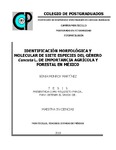| dc.description.abstract | La importancia del diagnóstico fitosanitario radica principalmente en la correcta identificación de los especímenes, que permite conocer el género y especie a la que corresponden, más cuando se trata de plagas cuarentenarias. Cuscuta spp., es considera una planta parásita, que afecta a sus hospedantes, ocasiona graves daños y pérdidas económicas y finalmente la muerte de sus hospedantes. La identificación de las especies de Cuscuta se ha basado en métodos morfológicos tradicionales; sin embargo, la determinación a nivel de especie es compleja por la metodología y los tiempos que implica; el objetivo de este trabajo fue generar una guía ilustrada que incluyera las características que apoyen a la identificación de siete especies de Cuscuta de importancia agrícola y forestal en México, así como la corroboración de esta identificación mediante el uso de los marcadores moleculares ITS y trnL-F. Se usaron las especies de Cuscuta campestris, C. chinensis var. applanata, C. tinctoria, C. costaricencis, C. corymbosa var. stylosa, C. mitriformis, y C. indecora que se tenían depositadas el herbario del Centro Nacional de Referencia Fitosanitaria, se identificaron las especies con las claves taxonómicas de Yuncker (1932; 1965), Costea y Tardif (2006), Costea et al. (2006, 2011, 2011a, 2012, 2013), medición de estructuras y comparación de ejemplares, así mismo, la identificacion molecular con los marcadores moleculares ITS y trnL-F, los fragmentos se amplificaron y se secuenciaron, con lo que se realizó un análisis filogenético. Los resultados de esta investigación fueron una guía pictográfica en donde se presentan las principales características taxonómicas que ayudan a la identificación de las siete especies de Cuscuta, así como la obtención de los perfiles genético de los marcadores ITS y trnL-F de siete especies de Cuscuta de importancia agrícola y forestal para México. _______________ MORFOLOGICAL AND MOLECULAR IDENTIFICATION OF SEVEN SPECIES OF THE GENERO Cuscuta L. OF AGRICULTURAL AND FOREST IMPORTANCE IN MEXICO. ABSTRACT: The importance of the phytosanitary diagnosis lies mainly in the correct identification of the samples, which allows knowing the the species to which it corresponds, more when it comes to quarantine pests. Cuscuta spp., Considers a parasitic plant, which affects the host species, causing severe damage and economic losses, in most cases causing the death of its hosts. The identification of the species of Cuscuta has been based on traditional morphological methods; however, the determination of the species level is complicated due to the methodology and the times involved; the objective of this work was to generate an illustrated guide that includes the characteristics that support the identification of seven Cuscuta species of agricultural and forestry importance in Mexico, as well as the corroboration of this identification through the use of the ITS and trnL-F molecular markers, samples of the species of Cuscuta campestris, C. chinensis var. applanata, C. tinctoria, C. costaricencis, C. corymbosa var. stylosa, C. mitriformis, and C. indecora found in the herbarium of the National Phytosanitary Reference Center, the species were identified with the taxonomic keys of Yuncker (1932; 1965), Costea and Tardif (2006), Costea et al. (2006, 2011, 2011a, 2012, 2013), measurements of structures and comparison of examples, likewise, the molecular identification of was performed with ITS y trnL-F molecular markers, the fragments were amplified and sequenced, then a phylogenetic analysis was performed. The results of this research were a pictographic guide where the main taxonomic characteristics that help to identify the seven species of Cuscuta are presented, as is the case of the perfection of the genetics of the ITS and trnL-F brands of their particular agricultural and forestry importation to Mexico. | es_MX |


